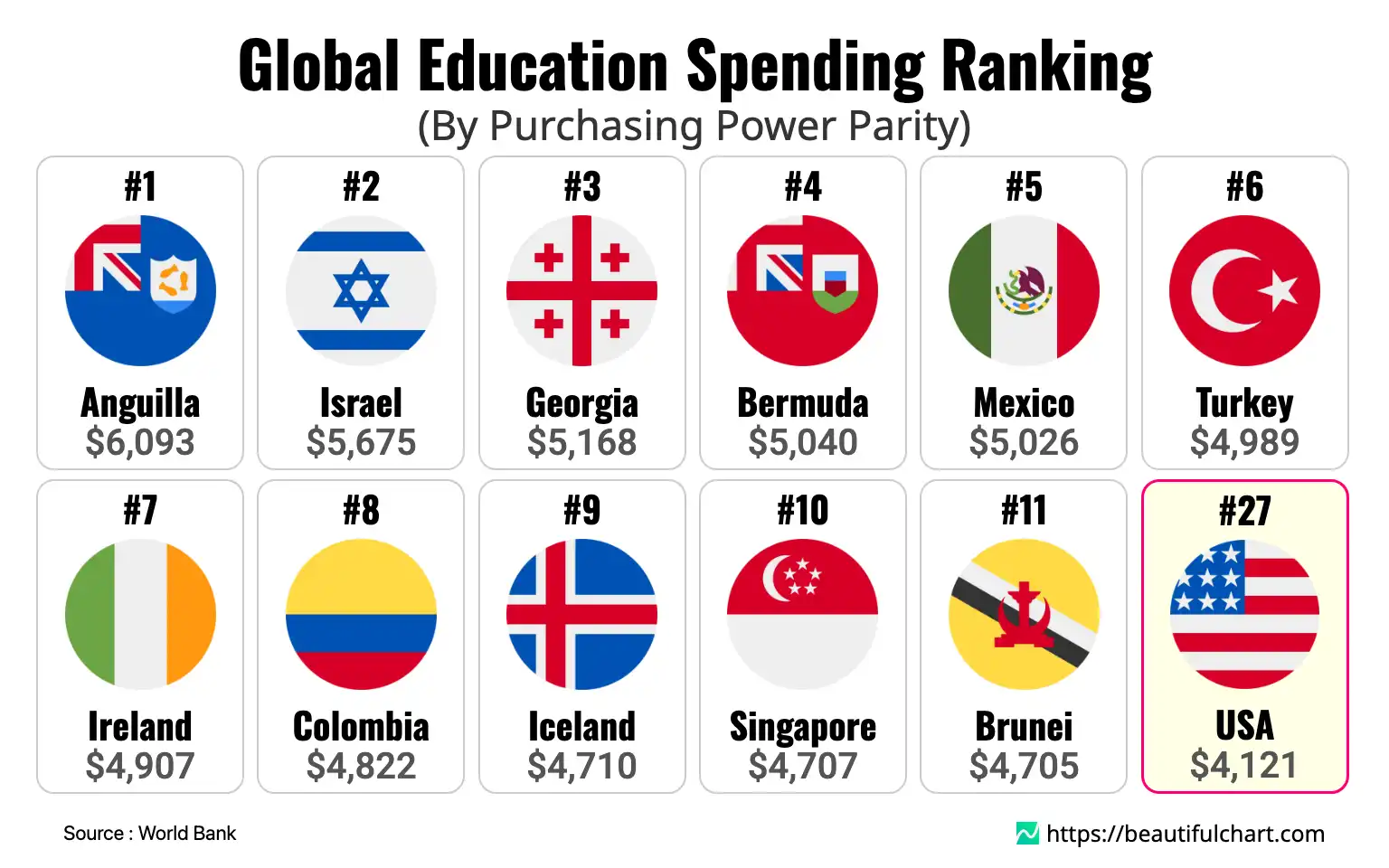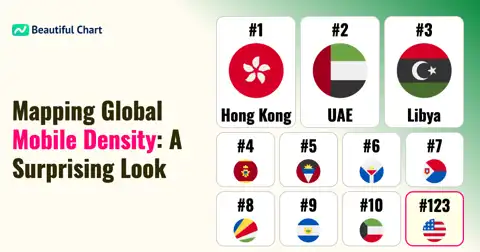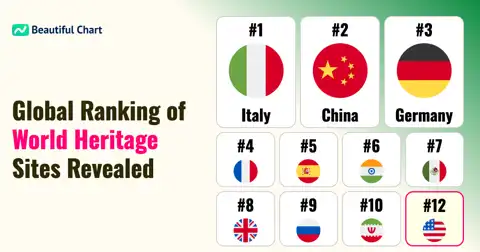A global analysis of annual per-capita spending on education reveals surprising leaders when adjusted for purchasing power parity. The British overseas territory of Anguilla tops the list, investing over $6,093 per person annually. It is followed by Israel, Georgia, Bermuda, and Mexico, all of which allocate more than $5,000 per capita. The data highlights a stark contrast between the top and bottom, with major economies like the United States ($4,121) ranking 27th, while several African nations spend less than $100, underscoring significant global disparities in educational investment.

Purchasing Power Parity (PPP) is an economic metric used to compare the currencies of different countries through a 'basket of goods' approach. It adjusts for differences in the cost of living and inflation, allowing for a more accurate comparison of economic productivity and standards of living. In this context, it standardizes education spending to reflect what that money can actually purchase in local educational services.
An examination of annual per-capita expenditure on education, standardized by purchasing power parity (PPP), provides a compelling look into national priorities and the global landscape of human capital investment. These figures offer a more equitable comparison than nominal values by accounting for local living costs, revealing how effectively financial resources translate into educational services in different countries.
The Unexpected Leaders in Education Investment
Notably, the top of the ranking is not dominated by the world's largest economies. Instead, smaller nations and territories lead the way. Anguilla's position at number one, with an expenditure of $6,093, is particularly striking. This suggests a focused government strategy on building a high-quality education system for its small population, likely to support specialized economies like tourism and finance. The presence of Israel, Georgia, and Bermuda in the top five further illustrates this trend. These countries, despite their varied economic profiles, demonstrate a profound commitment to education as a primary driver of innovation, economic resilience, and social progress. Their high investment levels reflect deliberate policy choices to cultivate a highly skilled workforce and maintain a competitive edge on the global stage.
A Look at Major Economies
The rankings of major economic powers offer a different perspective. The United States, for example, stands at 27th place with an expenditure of $4,121. While this represents a significant sum in absolute terms, its per-capita ranking indicates that many other nations are investing more relative to their population and domestic costs. Similarly, other G7 nations like the UK (28th), Canada (22nd), and Germany (39th) are also positioned outside the top tier. This doesn't necessarily imply a lack of resources but may point towards different allocation strategies, the scale of public versus private education funding, and the complexities of managing large, diverse educational systems. It raises important questions about the efficiency of spending and whether financial input is translating directly into superior educational outcomes compared to the leading countries.
The Stark Global Divide
The most dramatic story told by these figures is the immense disparity in educational opportunities worldwide. While the top countries invest thousands of dollars per person, nations at the bottom of the list, primarily in Sub-Saharan Africa, spend less than a few hundred dollars. Countries like Somalia ($56), DR Congo ($70), and Ethiopia ($120) face monumental challenges. This chasm in funding directly impacts access to basic literacy, quality of teaching, and availability of educational resources, perpetuating cycles of poverty and hindering sustainable development. The data powerfully visualizes the global inequality that international development efforts aim to address, highlighting the urgent need for greater investment and support for education in the world's most vulnerable regions.
Key Takeaways
Unexpected Leaders and Diverse Priorities
- Small nations and territories like Anguilla and Bermuda lead the rankings, demonstrating that high per-capita spending is not exclusive to large economies.
- The top of the list features a geographically diverse group, including Israel and Georgia, which indicates a widespread but varied global focus on education.
- High investment levels in these countries often reflect strategic policies aimed at developing knowledge-based economies and fostering a highly skilled workforce.
Position of Major Economic Powers
- Major economies such as the United States (27th), the United Kingdom (28th), and Japan (68th) are not among the top per-capita spenders when adjusted for PPP.
- Their rankings suggest that while absolute spending is high, it is comparatively lower than the leaders when factored against population size and local costs.
- This data raises questions about the efficiency of educational spending and policy priorities within these large, developed nations.
Extreme Global Disparity in Educational Investment
- The data reveals a vast gap between the highest and lowest spenders, with top countries investing over 100 times more than those at the bottom.
- Many nations, particularly in Sub-Saharan Africa, have critically low investment levels, which presents a major barrier to economic and social development.
- This disparity underscores the deep-rooted global inequality in access to quality educational opportunities.
Top Ranking
1st Anguilla: $6,093
As a British overseas territory in the Caribbean, Anguilla's top ranking is remarkable. This high per-capita spending reflects a strong government commitment to fostering human capital within its small population of around 15,000. The investment likely targets high-quality primary and secondary education, as well as vocational training, to support its tourism-driven economy and reduce reliance on foreign labor. This level of funding allows for smaller class sizes, modern resources, and competitive teacher salaries, creating a robust educational foundation for its citizens.
2nd Israel: $5,675
Israel's position as the second-highest spender underscores its long-standing focus on education as a cornerstone of its knowledge-based "Startup Nation" economy. The investment is spread across a high-quality public school system, renowned universities, and significant funding for research and development. This commitment is crucial for maintaining its competitive edge in technology, science, and innovation. The high spending reflects a cultural emphasis on academic achievement and is a key driver of the nation's economic resilience and technological advancements.
3rd Georgia: $5,168
Georgia's ranking in the top three highlights its strategic pivot towards human capital development following post-Soviet reforms. The nation has been actively modernizing its education system to align with international standards and foster a skilled workforce. This substantial per-capita investment likely targets curriculum reform, teacher training, and improving infrastructure to boost economic competitiveness and support its aspirations for closer integration with Europe. It signals a clear policy priority to move beyond its traditional economic sectors into a more diversified, service-oriented economy.
4th Bermuda: $5,040
Similar to Anguilla, Bermuda is a small, high-income British overseas territory. Its significant education expenditure is essential for supporting its sophisticated international business and finance sectors. The investment ensures a highly educated local workforce capable of filling roles in complex industries like insurance and reinsurance. The funding supports a mix of private and public schools that often follow international curricula, preparing students for higher education abroad and for careers in the global marketplace.
5th Mexico: $5,026
Mexico's inclusion in the top five is a significant finding for a large emerging economy. This high per-capita spending, adjusted for PPP, indicates a substantial national effort to address educational challenges and improve access and quality across its large and diverse population. This investment is likely part of broader reforms aimed at boosting economic productivity, reducing inequality, and providing opportunities for its youthful demographic. It reflects a strategic decision to invest in human capital as a primary engine for long-term sustainable development and social mobility.
27th USA: $4,121
The United States ranks 27th, with an annual per-capita education spending of $4,121. While the absolute dollar amount is among the highest globally, its ranking is moderated by its large population and high cost of living. The U.S. education system is a complex mix of public and private funding, with significant variations in spending between states and even districts. This figure represents an average that encompasses everything from K-12 public schools to its world-leading university system. The ranking sparks ongoing debates about the efficiency and equity of this spending in achieving desired educational outcomes compared to other nations.
| Rank | Name | Indicator |
|---|---|---|
1 | $ 6,093 | |
2 | $ 5,675 | |
3 | $ 5,168 | |
4 | $ 5,040 | |
5 | $ 5,026 | |
6 | $ 4,989 | |
7 | $ 4,907 | |
8 | $ 4,822 | |
9 | $ 4,710 | |
10 | $ 4,707 | |
11 | $ 4,705 | |
12 | $ 4,704 | |
13 | $ 4,696 | |
14 | $ 4,679 | |
15 | $ 4,608 | |
16 | $ 4,545 | |
17 | $ 4,545 | |
18 | $ 4,541 | |
19 | $ 4,498 | |
20 | $ 4,426 |





